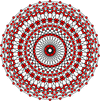issue contents
May 2019 issue

Cover illustration: ![[beta]](/logos/entities/beta_rmgif.gif) -Cu2-xSe has extraordinary thermoelectric properties, but the structure has remained elusive since 1936. Using the three-dimensional difference pair distribution function (3D-
-Cu2-xSe has extraordinary thermoelectric properties, but the structure has remained elusive since 1936. Using the three-dimensional difference pair distribution function (3D-![[Delta]](/logos/entities/Delta_rmgif.gif) PDF), which is a generalized Patterson function, the locally ordered structure in disordered Cu2-xSe can be solved by hand.
PDF), which is a generalized Patterson function, the locally ordered structure in disordered Cu2-xSe can be solved by hand. ![[beta]](/logos/entities/beta_rmgif.gif) -Cu2-xSe is built from perfectly ordered two-dimensional layers with a highly disordered stacking sequence. For a century crystallography has focused on crystalline order; now the 3D-
-Cu2-xSe is built from perfectly ordered two-dimensional layers with a highly disordered stacking sequence. For a century crystallography has focused on crystalline order; now the 3D-![[Delta]](/logos/entities/Delta_rmgif.gif) PDF provides a basis for developing the `crystallography of disorder' [Roth & Iversen (2019). Acta Cryst. A75, 465-473].
PDF provides a basis for developing the `crystallography of disorder' [Roth & Iversen (2019). Acta Cryst. A75, 465-473].
advances
research papers
 access
accessfoundations
research papers
 access
access access
access

 journal menu
journal menu

































